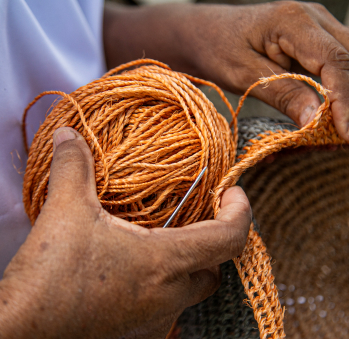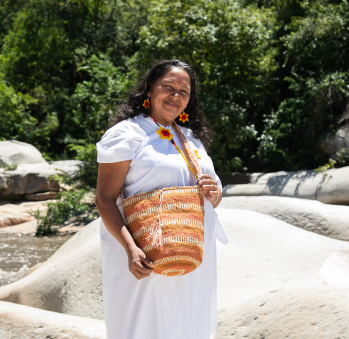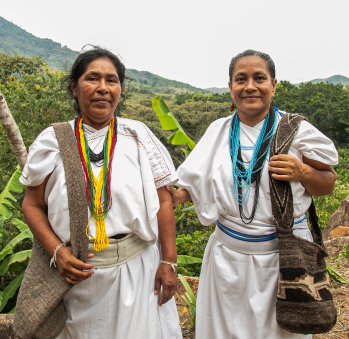Élsida Arias Villazón
Workshop: Mujeres Indígenas en Armonía
Craft: Tejeduría
Trail: Cesar Route
Location: Valledupar, Cesar
SCHEDULE YOUR VISIT
Los Haticos Cesar 1, Los Haticos, Valledupar, Cesar
3107036566
asoprohati@gmail.com
Élsida Arias begins her day at 7 am. Employing the carrumba, the spindle native to the department of Cesar, she deftly spins threads. By around 10 am, she starts preparing lunch, with yuca being an essential component. Amid cooking and tending the fire, she simultaneously twists together threads of hemp or wool. The image emerges of Élsida navigating her household, collecting timber, and intertwining threads, all at the same time. Residing in the Kankuamo community of Los Haticos, where the sun heats everyday, Élsida rests under the shade of the mangoes and the spanish lime, leafy trees that relieve her from the heat, after having lunch. Here, she embarks on weaving endeavors, takes leisurely walks, and attends to daily tasks. The evening brings her back inside her house, where her weaving continues.
Within her community, every individual weaves. Women, men, girls, boys, and elders —whose minds benefit from this exercise— engage in this practice. Each family weaves from their homes. Employing hemp or wool, they use a needle for stitching. Beginning with the chipire, the center and base of every bag, they first master this element during their initial introduction to this tradition as children. Gradually, they add more and more stitches to the chipire until they reach the desired width to commence building the bag’s body, which lifts straight. Finally, they craft the gauze, the bag’s strap, employing the needle once more. Altogether, crafting a bag is a meticulous process, with responsibilities distributed among the family members.
Los Haticos community members commonly cultivate an assortment of fruits, including mangoes, sapfruit, spanish lemons, and coconuts. It makes part of their household economies to grow mangoes and weave bags. Additionally, fruit peels are repurposed as feed for pigs or cows. During May, the harvest season, they have mango juice daily, while the rest of the year – with or without the presence of mangoes – they weave bags to ensure a steady income.
Kankuamo bags are woven from thoughts. According to Élsida, this practice embodies contemplation about her children, family, and their future. They weave with the intention of deriving sustenance from their craft, but also, they weave keeping their territory in mind. The act of weaving parallels the upward ascent of the Sierra Nevada mountains.
The Sierra Nevada, a shared domain among the Kankuamo people and neighboring Koguis, Wiwas, and Arhuacos, who altogether safeguard its territory, stands as a pivotal influence on their weaving traditions. The mountains and valleys of this landscape house the sheep and aloes from which artisans obtain wool and hemp. The same lands provide the rinds, vines, and roots historically used by Sierra’s inhabitants to dye hemp fibers. Among these resources is the brasil tree, offering red dye; batatilla, the source of yellow; and the chinguiza vine, a vine that gives pink hues. Notably, people from Los Haticos employ chinguiza branches to create shade canopies, shielding them from the sun’s rays as they weave – a shade that mirrors the shelter provided by mangoes, sapfruits, and lemon trees during their weaving endeavors.
Craft

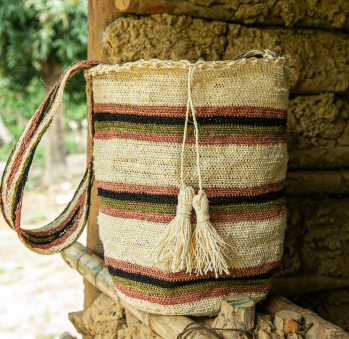

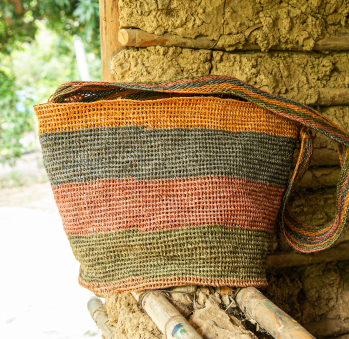






Artisans along the way
Artisans along the way
No puede copiar contenido de esta página











































